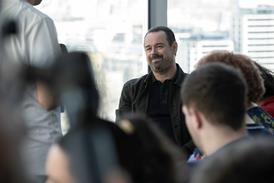We've been used to living in a world in which professional photographers take still pictures and professional video crews deal with moving images.
Not exactly ‘Never The Twain Shall Meet', but different people with differing (but related) skills, usually working for different parts of the business and to different briefs, paid out of different budgets.
Digital SLRs have been available for several years now, with all the usual interchangeable lenses that photographers rely on. They have brought a new immediacy to photojournalism. From image capture to publication, a high-resolution picture can be used to tell a story to millions in minutes.
At the top end of video production, a decent budget will give you the right equipment for the job.
Video options
Fully featured professional cameras that use the very best videotape or tapeless formats, the latter offering native NLE compatibility via removable Blu-ray-based discs, and even direct-to-edit digital workflows straight out of the back of the camera via a device like the Firestore.
If you haven't got the money, however, it is commonplace to make do with high-end consumer camcorders, which use inferior electronics, don't have interchangeable lenses, lack that all important external audio socket, are either ‘prosumer' tape-based (DV, HDV etc.) or do not support industry-standard professional codecs that allow easy import into an NLE. Some tapeless camcorders record to DVD, for example. Which is not much use.
Low-cost video recording options compromise both flexibility and the end product.
Whatever your budget, video recording also requires you to light your subject. This means more kit, more people, more expense.
New rules
Now, however the rules can and probably will be re-written, at least a bit. The arrival of the 21 megapixel Canon 5D Mark II- which also shoots 1080p 30fps video - and the 12 megapixel Nikon D90, which shoots 720p at 24fps are something of a watershed.
Apart from the price -£2,300-ish, body only, for the Canon and around£650 for the Nikon, again body only - you can only smile when you realise how much versatility these things offer. Bear in mind, these are stills cameras.
First, let's deal with portability. On its own, the Canon weighs less than a kilo. Even in a big bag with a comprehensive lens selection, you're talking ‘carry-on luggage'. The Nikon's even lighter - 650g (1lb 6oz in old money).
Everything you need hanging off one shoulder. What about lights? Aren't you going to needs lights?
Both cameras have great low-light sensitivity. The Canon has a “full frame” 24mm x 36mm CMOS sensor. The Nikon's is slightly smaller - 16mm x 24mm - but even that is still more than adequate if you don't need to aim too high quality-wise and want to save some money.
A new dawn
When everything's taken into account, my guess is, shooting HD video using available light and drawing on all your knowledge of photographic techniques is going to beat lugging lighting gear around and paying a crew.
The availability of interchangeable lenses, again, when combined with those basic photography skills, makes these cameras really attractive for anybody who needs to get some great stills and also shoot a few minutes of high quality, well-framed video that captures the atmosphere and does the job.
Recent announcement of cutbacks at news organisations and the erosion of a demarcated job market bring versatility into sharp focus (sorry, I couldn't resist it).
If you can go out on a news assignment, or a corporate job, or to record an insert for a documentary or even to shoot a shaky handheld sequence for an art house movie for that matter, with a camera that also allows you to take some fantastic stills, I'm with the reviewers in the photography and computer user magazines. These cameras are the proverbial ‘no-brainer'.
Colin Birch is a writer, producer and consultant. His website, ‘The Broader Issue', contains interviews, features and discussion programmes on a wide range of subjects from around the content business, published as audio podcasts. Birch is also the writer and publisher of “Why IBC?”, the official IBC weblog. When not writing or producing content he provides marketing consultancy and technology training services, the latter with a business partner, as Informed Sauce.
Fancy being a guest blogger? Email will.strauss@emap.com with your ideas.




























No comments yet